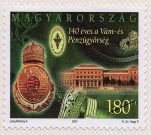THE CUSTOMS AND FINANCE GUARD IS 140 YEARS OLD
Date of issue: 10 March 2007
Following the Compromise of 1867, on 10 March finance minister Menyhért Lónyay issued circular decree no. 1, establishing the Hungarian royal inspectorates, including the independent Hungarian Finance Guard. Documents containing detailed rules of its operation, including the legal regulation of the salt, tobacco and lottery régies, and taxes on spirits, beer and sugar, and wine and meat excise, were completed in 1868. Act XXI of 1868, §96 places the finance guard and thus the finance body into a key position as regards the collection of duties and taxes. After World War I, the body was reorganised. Throughout the 1920s-30s the Customs and Finance Guard’s border posts were built, and the separation of the customs guards and the customs services started. The job of the former began to be limited to protecting the frontiers and was named the border guard. After World War II, the tasks of the finance guard and the customs service remained supervising the regies, excise duties, and the purchase taxes and duties. Around 1947 certain elements of the Soviet-type economic and political system restricting the market emerged. The National Finance Guard Directorate was established as an independent department in the Finance Minis-try. In 1964, under the supervision of the Finance Ministry, the Finance Guard and the Customs Guard merged. In 1966, in preparation for the new economic mechanism, regulations on different levels were passed on customs and commercial customs tariffs. These also contained the internationally accepted legal principles of the era. In 1990 the road to a market economy was opened, and the Customs and Finance Guard played a key role in the reorganisation. On 1 July 1993 the Act on Excise Duties was passed. The legal milestone as regards customs was the Act on Customs of 1995 and the Act on Customs Tariffs. With Hungary’s EU accession the entire organisational structure was vetted and reorganised, and its duties were renewed to reflect EU requirements. (Source: Dr. Köpf, László: A Vám- és Pénzügyőrség története [History of the Customs and Finance Guard])

The stamp shows the arms on the shako of the Hungarian Royal Finance, Customs and Tax Guard, and the building of the former Customs Palace. In the background there is a detail of a shako and an officer’s sword. The first day cover’s main motif is a contemporary uniform, while in the background there are documents and other typical motifs. The post-mark shows a stylised officer’s shako.
Order code:
2007023010031 (stamp)
2007023060032 (FDC)
Date of issue: 10 March 2007
Face value: HUF 180
Perforated size: 40 x 30 mm (in sheets of 50 stamps)
Printed by Pénzjegynyomda Zrt.
Photo by András Láng-Mititczky
Designed by Péter Nagy

